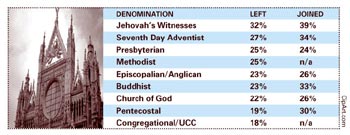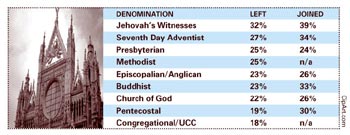If it seems most everyone in your church used to be “something else,” they did. More than 33 million adults in the United States reported they had changed their religious identification or preference at some point in their lives, according to a study by the City University of New York. That’s 16 percent of the total adult population. Demographers call this faith-shifting phenomenon “religious mobility,” and it’s on the rise.

The U.S. population remains predominantly Christian. In 2001, 77 percent self-identified as Christian, although that number is down from 86 percent in 1990. The number of people identifying with any religion also declined in the same period, from 90 percent to 81 percent.
While mainline Protestant groups are declining, evangelical and charismatic denominations are on the rise. Of those who identify themselves as “evangelical/born-again,” 37 percent “switched” to the faith from another religion.
Who’s moving: The shift is greatest among mainliners, smaller faiths and sects. Jehovah’s Witnesses are most “mobile.” Accounting for less than 1 percent of American adults, one-third of their members leave the group, and two-fifths join from another religion.
Implications for church leaders: Religious mobility means we cannot assume that members understand basic faith tenets, denominational distinctives, or heritage. But, that they’ve switched brands doesn’t mean they’ll sign up for history lessons. Heritage and distinctives must be communicated along with vision and goals in existing teaching venues and in church communiqués.
Expect practices from other churches to seep into your system as leaders from other backgrounds join the team.
And we must watch out for acronyms. Insider language creates outsiders and makes newcomers feel like strangers. Besides, who recalls what BYPU is anyway?
—data from American Demographics (March 2003)
Copyright © 2003 by the author or Christianity Today/Leadership Journal.Click here for reprint information onLeadership Journal.










